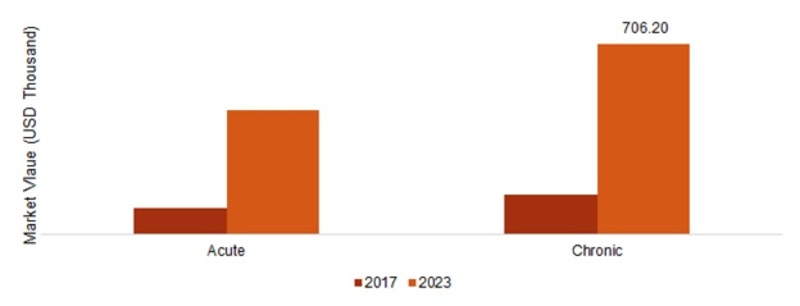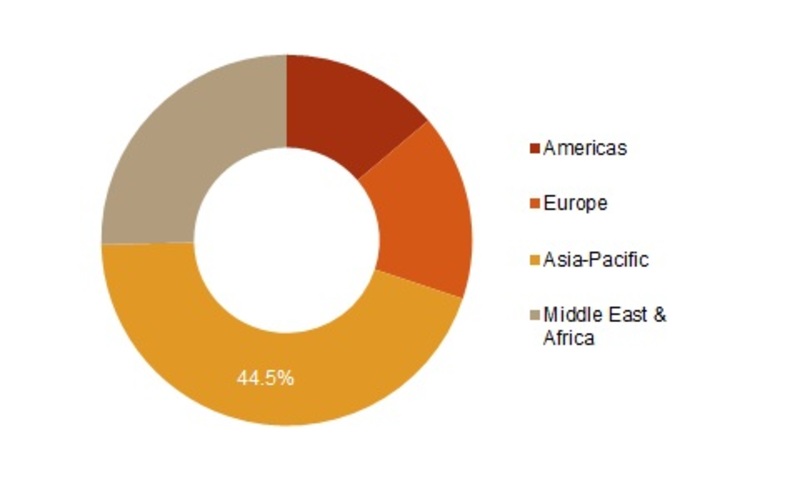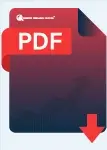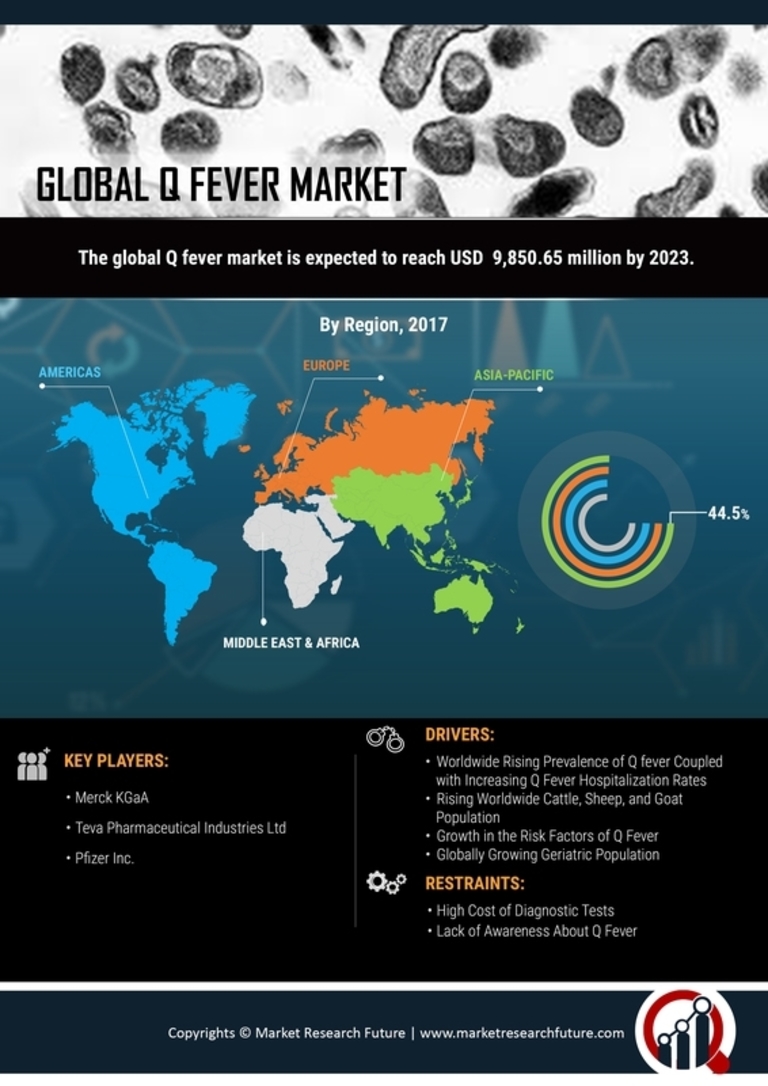Q fever market Overview
The Q Fever market is anticipated to reach USD 4213.38 Million by 2030 at 4.60% CAGR during the forecast period 2022-2030. Some of the protuberant drivers supporting the growth of the Q fever market are identified as growth in the prevalence of chronic diseases and the increasing number of patients suffering from various bacterial infections.
The rising prevalence of Q fever coupled with increasing Q fever hospitalization rates, rising worldwide cattle, sheep, and goat population, growth in the risk factors of Q fever, and globally growing geriatric population are expected to drive the Q fever market in coming years.
Synopsis/Market Dynamics
Q fever is a bacterial infection caused by the bacteria Coxiella (C.) burnetii. C. burnetii has a reservoir in birds and mammals, especially cattle, sheep, and goats, and is most often an occupational disease affecting farmers, veterinarians, and slaughterhouse workers. The Q fever infection, mostly chronic Q fever is severe with complications including endocarditis, encephalitis, pneumonia, hepatitis, and splenomegaly requiring hospitalization. As per the data provided by the Centers for Disease Control and Prevention (CDC), between 2002 and 2014, the Q fever hospitalization rates were increased from 25.0% to 68.0%. In the US, the prevalence of Q fever was high in four states, namely, California, Texas, Colorado, and Illinois. Additionally, in 2014, the highest incidence rate of Q fever which was at least 1.0 case per million persons was found in Arizona, Arkansas, Colorado, Idaho, Montana, Nebraska, North Dakota, Oregon, South Dakota, Utah, and West Virginia. Moreover, according to the European Centre for Disease Prevention and Control (ECDC), in 2016, 1,102 cases of Q fever were reported in the European Union (EU)/European Economic Area (EEA), out of which 1,058 (96%) were confirmed.
Q fever Market Revenue, by Type, 2017 & 2023 (USD Mn)

Segmentation
Global Q fever, by type, segmented into acute and chronic. Chronic is the leading segment, which is growing at the highest CAGR to reach USD 706.20 thousand during the forecast period. Chronic Q fever is a life threating problem and causes damage to the heart, lungs, liver, brain, and could cause diabetes as well. The major share of the chronic segment is attributed to its high prevalence.
Based on diagnosis, Q fever market is segmented into serology tests and others. The serology tests account for major share with 8.32% CAGR during the forecast period. Under the serology test, Q fever is diagnosed through antibody blood tests, polymerase chain reaction (PCR) tests, immunoperoxidase staining, complement fixation, enzyme-linked immunosorbent assay (ELISA) tests, and other molecular tests.
The Q fever market, by treatment, is segmented into antibiotic and surgery. The antibiotics segment accounts for the second largest share in the market with 7.32% CAGR during the forecast period. Surgery is an important component of treatment if patients have extensive valvular damage or indications of heart failure.
On the basis of end user, the market is segmented into patients, hospitals and clinics, and others. The patient segment accounted for a considerable market share of 72.1% as of 2017.
Global Q fever Market Share, by Region, 2017 (%)

Regional Analysis
The Asia-Pacific accounted for the largest market share of 44.5% as of 2017 and is projected to grow at the highest CAGR of 8.57% during the forecast period. The increasing prevalence of chronic diseases such as diabetes, cancer, and bacterial infection in developing countries is the major driver for market growth. According to the International Diabetic Federation, about 415 million people had diabetes across the globe in 2015, which is expected to reach 642 million by 2040. It also stated that 98.4 million and 65.1 million diabetic population lived in China and India, respectively.
The Asia-Pacific is followed by Europe, which accounted for a major market share. The European market is expected to grow at a strong growth rate during the forecast period owing to the availability of advanced treatment facilities and healthcare expenditure along with growing pet adoption.
The Americas accounted for a significant share in the Q fever market. It is attributed to the increasing adoption of pets, increasing preventive treatments, and care facilities for companion animals, rising technically advanced devices, and growing awareness regarding animal-transmitted diseases.
Key Players
The prominent players in the Q fever market are Merck KGaA (Germany), Teva Pharmaceutical (Israel), Pfizer Inc. (US), Basilea Pharmaceutica Ltd (Switzerland), Sanofi S.A.(France), Melinta Therapeutics, Inc. (US), Bayer AG (Germany), Johnson & Johnson Services, Inc. (US), Yashica Pharmaceuticals (India), AtoxBio (US), and others. Some of the key strategies followed by the players operating in the Q fever market were innovation, product development, acquisition, and expansion.
- In September 2017, Basilea Pharmaceutica Ltd entered into a development, manufacturing, and commercialization agreement with Gosun Pharmaceutical Co. Ltd. to develop, manufacture, and commercialize Basilea's antibiotic ceftobiprole in China, Hong Kong, and Macao.
- In June 2017, Sanofi signed a strategic partnership with Eurapharma in Morocco. With this, Sanofi aims to strengthen its pharmaceutical business in Morocco and another African market.
- In June 2017, Melinta Therapeutics, Inc. got FDA approval for its antibiotic drug Baxdela (delafloxacin) for clinical indications such as infections.
Market Segmentation
Q fever Market, By Type
Q fever Market, By Diagnosis
Q fever Market, By Treatment
Q fever Market, By End User
- Patients
- Hospitals
- Others
Q fever Market, By Region
- North America
- Europe
- Germany
- Russia
- France
- Italy
- UK
- Rest of Europe
- Asia Pacific
- China
- India
- Japan
- Rest of Asia Pacific
- Latin America
- Brazil
- Mexico
- Argentina
- Rest of Latin America
- Middle East & Africa
Available Additional Customizations
- Company Profiles of Other Key Players
- Cipla Inc. (India)
- CSL Limited (Australia)
Intended Audience
- Pharmaceutical Manufacturers and Suppliers
- Medical Research Laboratories
- Research and Development (R&D) Companies
- Market Research and Consulting Service Providers
- Potential Investors
|
Report Attribute/Metric
|
Details
|
|
Market Size
|
· 2030: USD 4213.38 Million
· 2030: Significant Value
|
|
CAGR
|
4.60% (2022-2030)
|
|
Base Year
|
2021
|
|
Forecast Period
|
2022-2030
|
|
Historical Data
|
2018
|
|
Forecast Units
|
Value (USD Million)
|
|
Report Coverage
|
Revenue Forecast, Competitive Landscape, Growth Factors, and Trends
|
|
Segments Covered
|
Type, Diagnosis, Treatment
|
|
Geographies Covered
|
North America, Europe, Asia-Pacific, and Rest of the World (RoW)
|
|
Key Vendors
|
Merck KGaA (Germany), Teva Pharmaceutical (Israel), Pfizer Inc. (US), Basilea Pharmaceutica Ltd (Switzerland), Sanofi S.A.(France), Melinta Therapeutics, Inc. (US), Bayer AG (Germany), Johnson & Johnson Services, Inc. (US), Yashica Pharmaceuticals (India), AtoxBio (US), and others
|
|
Key Market Opportunities
|
New product launches and R&D Amongst major key Players
|
|
Key Market Drivers
|
Growing geriatric population
|
Q Fever Market Highlights:
Frequently Asked Questions (FAQ) :
Q fever market is projected to grow at a 4.60% CAGR between 2022-2030.
The Americas is expected to lead Q fever market.
Q fever market is predicted to touch USD 4213.38 Million by 2027.
Increasing hospitalization rates and rising prevalence of various bacterial infections are the key factors driving the Q fever market.
Chronic and acute are the different types of acute fever.





























